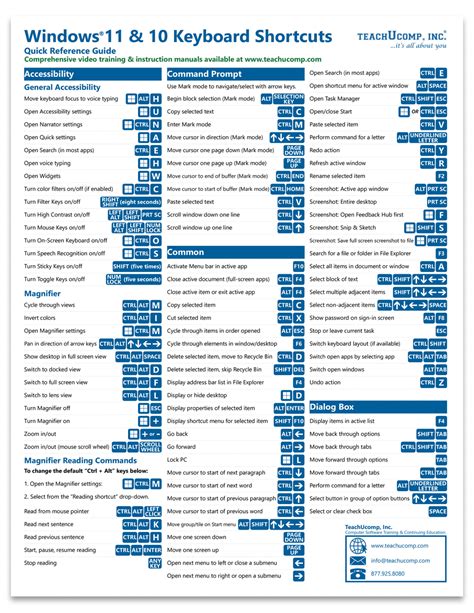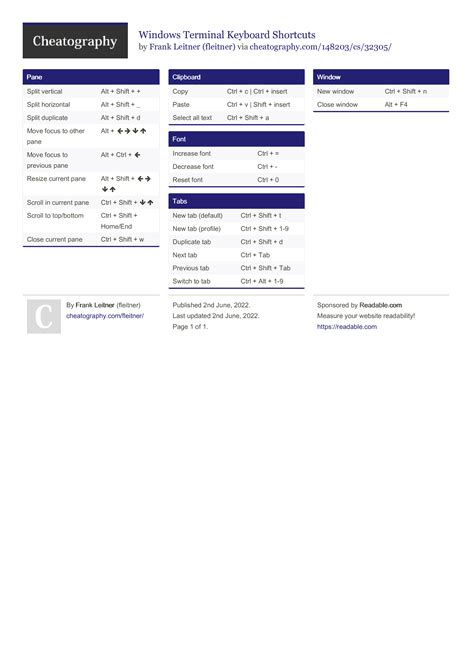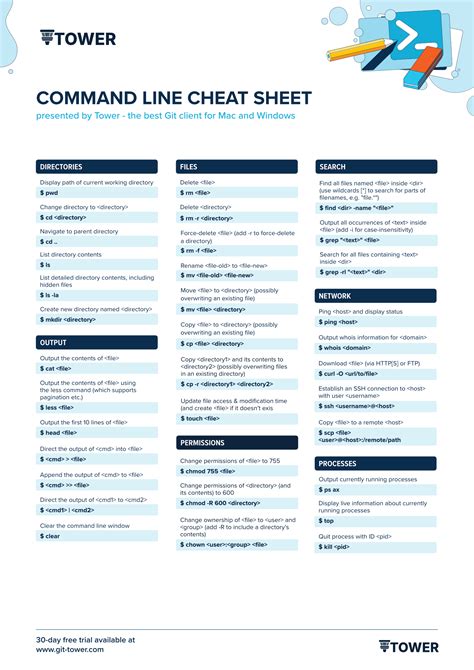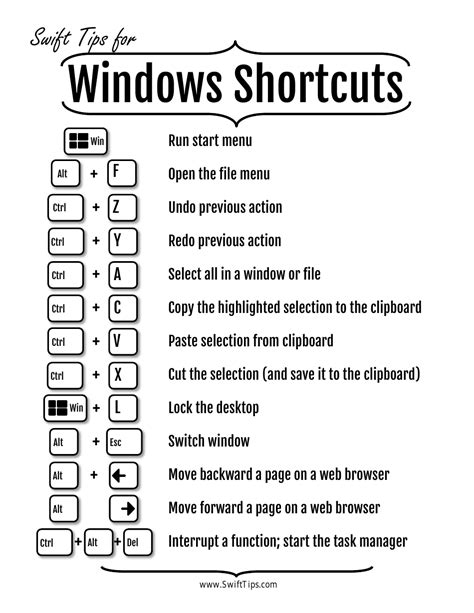Windows Terminal Keyboard Commands Cheatsheet

The Windows Terminal is a powerful and versatile tool that has become an essential companion for developers, system administrators, and power users alike. Its feature-rich interface and customizable nature make it a popular choice for those seeking an efficient and productive command-line experience. Central to this experience are the keyboard commands, which allow users to navigate, manage, and manipulate the terminal environment with speed and precision. This comprehensive guide will serve as a detailed cheatsheet, exploring the vast array of keyboard commands available in the Windows Terminal, their functions, and practical use cases.
Navigating the Windows Terminal

Efficient navigation is the cornerstone of effective terminal usage. The following keyboard commands are instrumental in swiftly moving around the terminal interface:
Scrolling and Positioning
- Shift + Page Up: Scroll up one page.
- Shift + Page Down: Scroll down one page.
- Ctrl + Shift + Home: Scroll to the top of the terminal.
- Ctrl + Shift + End: Scroll to the bottom of the terminal.
- Ctrl + ↑ or Alt + ↑: Move the cursor to the start of the current line.
- Ctrl + ↓ or Alt + ↓: Move the cursor to the end of the current line.
History Navigation
The Windows Terminal maintains a history of previously entered commands, which can be navigated using the following commands:
- ↑ or ↓: Navigate through the command history, moving up or down one command at a time.
- Ctrl + R: Start a reverse search through the command history. Type a keyword to search for a specific command.
- Ctrl + S: Start a forward search through the command history.
- Ctrl + G: Jump to the most recent command in the history.
Cursor Movement
Precise cursor movement is essential for editing and selecting text. These commands allow for fine-grained control:
- ← or →: Move the cursor left or right one character.
- Home or End: Move the cursor to the beginning or end of the current line.
- Ctrl + ← or Ctrl + →: Move the cursor one word to the left or right.
- Ctrl + ↑ or Ctrl + ↓: Move the cursor up or down one line.
Editing and Selecting Text

Efficient text editing and selection are critical for command-line productivity. The following commands provide powerful tools for these tasks:
Text Editing
- Backspace: Delete the character to the left of the cursor.
- Delete: Delete the character to the right of the cursor.
- Ctrl + D: Delete the character to the right of the cursor and exit the current line.
- Ctrl + K: Delete the text from the cursor position to the end of the line.
- Ctrl + U: Delete the entire line.
- Ctrl + Y: Paste the previously deleted text.
Text Selection
Selecting text is crucial for copying, moving, or editing multiple characters or lines at once. These commands facilitate text selection:
- Shift + ← or Shift + →: Select text character by character in the direction of the arrow.
- Shift + ↑ or Shift + ↓: Select text line by line in the direction of the arrow.
- Shift + Home or Shift + End: Select text from the cursor position to the beginning or end of the line.
- Shift + Ctrl + ↑ or Shift + Ctrl + ↓: Select text from the cursor position to the start or end of the screen.
Clipboard and Paste Commands
The clipboard is a powerful tool for transferring text between applications and the terminal. These commands manage the clipboard and pasted text:
Clipboard Management
- Ctrl + C: Copy the selected text to the clipboard.
- Ctrl + Insert: Copy the selected text to the clipboard without clearing the selection.
- Ctrl + V or Shift + Insert: Paste the clipboard content at the cursor position.
- Ctrl + Shift + V: Paste the clipboard content, preserving any formatting.
Pasting with History
The Windows Terminal allows for pasting from the command history. These commands facilitate this process:
- Alt + .: Paste the last argument of the previous command.
- Alt + +: Paste the second-to-last argument of the previous command.
- Alt + -: Paste the first argument of the previous command.
Session Management and Profile Switching
The Windows Terminal supports multiple profiles and sessions, allowing users to switch between different environments seamlessly. These commands manage these sessions and profiles:
Profile Switching
- Ctrl + Shift + P: Open the profile selection menu, allowing users to switch between active profiles.
- Ctrl + D: Close the current terminal tab.
- Ctrl + Shift + N: Open a new terminal tab with the default profile.
Session Management
- Ctrl + Shift + W: Close the current terminal window.
- Ctrl + Shift + S: Split the terminal window horizontally.
- Ctrl + Shift + V: Split the terminal window vertically.
- Ctrl + Shift + Q: Quit the terminal application.
Other Useful Commands

The Windows Terminal offers a host of additional commands for various tasks and customizations. Here are some notable ones:
Customization and Settings
- Ctrl + ,: Open the settings window, allowing users to customize terminal appearance, profiles, and keyboard shortcuts.
- Ctrl + Shift + F: Toggle full-screen mode.
- Ctrl + Shift + I: Open the terminal in an integrated development environment (IDE) mode, useful for coding.
Quick Actions
- Ctrl + L: Clear the terminal screen.
- Ctrl + Z: Suspend the current process.
- Ctrl + Shift + Space: Insert a non-breaking space character.
- Ctrl + T: Open a new terminal tab with the same profile as the current tab.
Special Characters
The Windows Terminal supports the insertion of special characters, which can be useful for various tasks:
- Ctrl + @: Insert a special character (e.g., ©, ®, ™, etc.)
- Ctrl + Alt + /: Toggle between numeric and special character input modes.
Performance and Troubleshooting
The Windows Terminal offers several commands for performance optimization and troubleshooting:
Performance Tuning
- Ctrl + Shift + X: Open the experimental settings, providing access to advanced features and performance optimizations.
- Ctrl + Shift + F5: Refresh the terminal, clearing any cached data and restarting the terminal process.
Troubleshooting and Diagnostics
- Ctrl + Shift + H: Open the terminal’s help menu, providing access to documentation and troubleshooting resources.
- Ctrl + Shift + C: Copy the terminal’s diagnostic information to the clipboard, useful for reporting issues.
Conclusion
Mastering the keyboard commands in the Windows Terminal is a key step towards unlocking its full potential. With efficient navigation, precise text manipulation, and powerful session management, users can significantly boost their productivity and streamline their command-line workflows. This cheatsheet provides a comprehensive overview of the most useful commands, serving as a valuable reference for both novice and experienced users alike. By incorporating these commands into their daily routines, users can harness the full power of the Windows Terminal and elevate their command-line experience to new heights.
How can I customize keyboard shortcuts in the Windows Terminal?
+You can customize keyboard shortcuts in the Windows Terminal by opening the settings window (Ctrl + ,) and navigating to the “Keyboard” section. Here, you can modify existing shortcuts or create new ones by associating a command with a specific key combination.
Can I use mouse actions to navigate the terminal?
+Yes, the Windows Terminal supports mouse actions for navigation. You can use the mouse wheel to scroll up and down, and clicking with the mouse can move the cursor to that position. Additionally, right-clicking provides access to a context menu with various options, including copy and paste.
How do I manage multiple terminal tabs efficiently?
+To manage multiple terminal tabs efficiently, you can use keyboard shortcuts. Ctrl + Shift + N opens a new tab, and Ctrl + Shift + P allows you to switch between tabs. You can also split the terminal window horizontally or vertically to work on multiple tasks simultaneously.
Are there any keyboard commands for quick text formatting?
+Yes, the Windows Terminal provides keyboard commands for quick text formatting. Ctrl + Shift + V allows you to paste text while preserving its original formatting. Additionally, Ctrl + @ inserts a special character, which can be useful for adding copyright or trademark symbols.



